its paid sponsors, whose products you need!
| Home |
| Intro |
| Current Issue |
|
Mailing List |
| Store |
| Strength |
| Subscriber Content |
| ARCHIVES
|
| Martialism |
| Pacifism |
| Q & A |
| Cunning-Hammery |
| Advertise With Us |
| Submit An Article |
| Staff |
| Discussion Forum |
| Links |
“Stay ‘unreasonable.’ If you
don’t like the solutions [available to you], come up with your
own.”
Dan Webre
The Martialist does not
constitute legal advice. It is for ENTERTAINMENT
PURPOSES ONLY.
Copyright © 2003-2004 Phil Elmore, all rights
reserved.
The 20-Minute Tactical 10/22
By Stephen Mallory
The word “tactical” is used a lot these days. When I
hear “tactical” I think of black plastic and rugged looks. A “tactical”
rifle is an all-business, scary looking thing good for shooting bad guys and
not much else. Being a martialist myself, I thought my home
defense options were not complete without a tactical rifle of my own. I
thought it might be fun to see how quickly and easily I could put together a
politically incorrect defense gun from a popular plinker: the
Ruger 10/22.
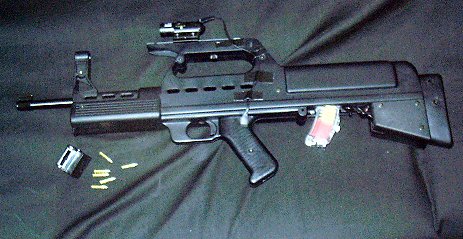
The finished Tactical 10/22. Project time was
20 minutes with all parts on hand.
I bought a Ruger 10/22 new on sale and then paid half as
much for a
Muzzlelite Bullpup Stock. The stock is made of plastic and puts the
trigger group forward of the magazine in order to shorten the overall length
of the rifle. In the new stock, the Ruger measures just over the Federal
length limit for rifles.
EDITOR’S NOTE: Check your state laws
regarding aftermarket stocks, barrel lengths, and overall lengths!
While the commercial Muzzlelite stock meets Federal requirements, there is
at least one state in which the overall rifle length is too short and
requires the addition of a muzzle compensator or other accessory to fall
within legal limits. Your state may have “assault rifle” legislation
that concerns adding a pistol grip, too.
The first thing you have to do to convert the standard 10/22
is remove it from its factory wood stock. There’s a screw around the
barrel band and another under the stock forward of the trigger. You have
to remove these and slide the barrel band off the front. I used a screwdriver
to spread the barrel band so it would come off. With the mechanical guts
of the Ruger free of the non-tactical wood, I was ready to get started.
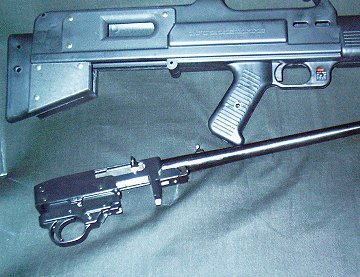
Muzzlelite Bullpup Stock (top) with Ruger action and
barrel.
The factory magazine release just won’t do.
You have to press up into the rifle to make it work and it’s a big pain.
For only a few dollars I bought an extended magazine release. All I had
to do was slide out one pin, pull the old release, and insert the new one.
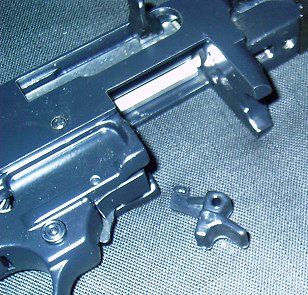
Factory magazine release is inconvenient. The
extended
release shown here drops in quickly and easily.
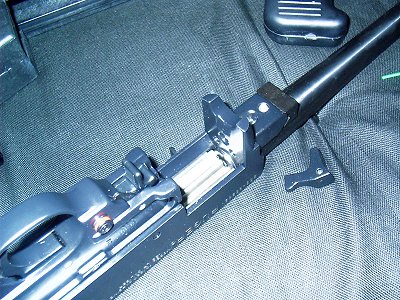
The extended magazine release is installed in this
picture. The
factory release is on the blanket to the right.
When I researched the 20-minute tactical 10/22
project on the Internet I did a lot of research at
www.rimfirecentral.com.
It was there that I picked up the next tip. I used a knife to remove
some of the plastic from both halves the stock (it comes in two parts that
screw together) in front of the trigger. When completed the rifle still
has to be tested to make sure it will fire reliably. If it doesn’t, more
plastic might need to be removed. That would extend the total project
time, but it is a minor correction. If there is too much plastic
blocking the Bullpup trigger, it will not “reset” with each new shot because
the trigger will bind up when it tries to come forward. Don’t confuse
this with “filing down” anything in the rifle to make it “automatic,” or
anything like that. The mechanics of the rifle just don’t work that way.
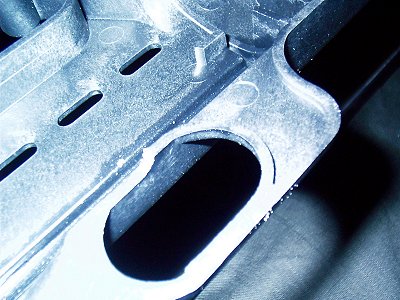
Both halves the stock have to have some plastic
removed for better
trigger action. I didn’t want to remove too much to start.
Once I had the stock and the mechanical parts
ready it was time to put them together. A plastic lever fits over the
factory trigger and connects to the new Bullpup trigger. The
instructions said to lube the trigger and the trigger pin that pushes against
it, so I used a little gun oil. When everything was pressed into place I
laid the right half of the Bullpup stock over the left half.
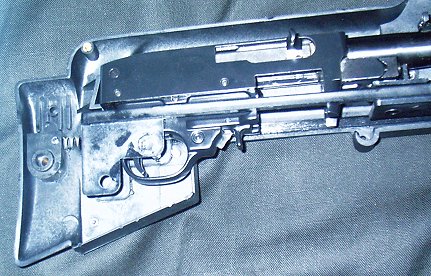
Ruger 10/22 action installed inside left half of
Bullpup stock.
You could stop at this point and you’d have a
functioning rifle. The plastic stock houses a replacement sighting
system that sits much higher than the barrel. It’s not very accurate,
but you didn’t want a target rifle. You wanted a tactical .22 that
throws lead at the bad guys and that’s what you got. Several allen-head
screws hold the Muzzlelite stock together (there’s a little flathead screw
too). It feels a little sloppy because it’s two halves bolted together
instead of one piece of wood. It works well enough to pump bullets
downrange.
EDITOR’S NOTE: The resulting commercial
Bullpup conversion is NOT an automatic weapon or “machine gun,” nor can it
be converted to such a weapon. The plastic trigger arm of the Bullpup
stock simply presses the factory trigger face. The weapon “looks
scary,” but it isn’t some evil death machine. Any functional gains are
confined to making the Ruger more compact and thus handier (but also
unusable for left-handed shooters).
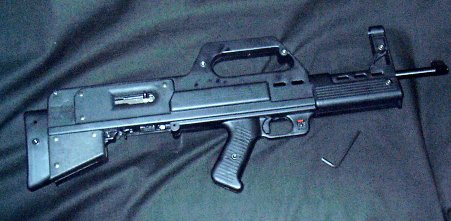
Completed Bullpup rifle conversion. It truly is
a “drop-in” unit with a few tweaks.
I added clear plastic Steel Lips magazines to
my Tactical 10/22. They’re not as reliable as the factory mags, but they
give you something to grab (because they extend out of the body of the rifle)
if you press the magazine release and the magazine doesn’t drop free.
When they’re fully loaded you can also tell that they are loaded
because you can see through them. Pre-ban high-capacity magazines are
available, but the curve of the magazine may make it hit the pistol grip if it
is too long.
EDITOR’S NOTE: Reliability is
always a concern, particularly in a defensive firearm. Adding an
aftermarket magazine is therefore a trade-off. Ruger factory magazines
are widely known to be extremely reliable, so you’re not likely to find an
aftermarket magazine that isn’t less reliable, if only by a small
margin. The Steel Lips magazines are pretty good, though, because they
have metal lips and and a metal stud that locks them properly in place on
the rifle. All-plastic aftermarket magazines, by contrast, frequently
do not lock reliably in place and are prone to jamming (especially with
certain brands of ammunition).
The last step was to add the accessory that
defines the ugly black plastic home defense gun: a laser sight. I bought
a pretty cheap unit at the sporting goods store. The Muzzlelite stock
comes with a plastic scope mount that is bolted to the “carrying handle” part
of the stock from underneath. I mounted my scope to that and put the
pressure switch on the pistol grip where I can activate it by tightening my
thumb against the grip.
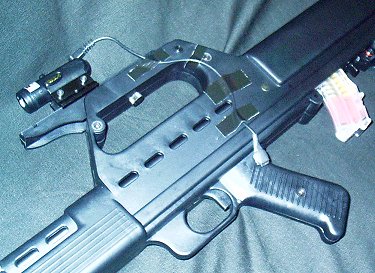
Laser sight unit mounted. Switch is secured with
electrical tape.
After 20 minutes I was done with my project. What I
have now is a mean-looking rifle that is compact and can put multiple rounds
into a home-breaker with just enough accuracy at close range. The laser
sight makes it easy to use at night and in darkened rooms. It is light
enough to be fired with one hand and I have set up the laser so a natural
motion of my fist activates the beam. Yes, I have my black plastic
“tactical” gun.
In twenty minutes, you can have one too.
